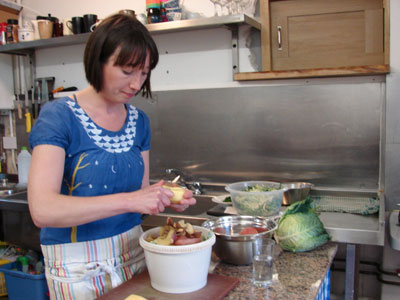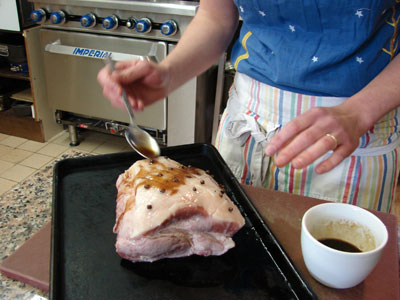What's cooking in...Ireland
This item appears on page 56 of the November 2011 issue.
When my husband, John, and I were in Roscommon, Ireland, in June 2011, we contacted Sarah Browne (Antogher Rd., Roscommon, Co. Roscommon; phone 0879439446) to set up a cooking experience featuring Irish food.
She offers a variety of cooking classes, ranging in cost from $43 to $157. Though there were no classes scheduled on the days we were in the area, she kindly offered to prepare a traditional Irish meal with us for the cost of the ingredients.
I had always considered corned beef and cabbage to be the signature Irish dish, and I usually make it for St. Patrick’s Day, boiling the corned beef, cabbage, potatoes and carrots together.
I was surprised to learn that in Ireland the traditional dish is bacon served with a side of Savoy cabbage boiled in the bacon water, accompanied by champ; champ is mashed potatoes seasoned with scallions, milk, butter, salt and pepper. (The potatoes are not cooked in the bacon water.)
Sarah made a parsley sauce of flour, butter, whole milk and fresh parsley, seasoned with salt and pepper, which she served on top of the slices of bacon.
Sarah, like most people in Ireland, where grass-fed meats and local dairy products are the norm, knows the sources of her food. She has her own herb-and-vegetable garden adjacent to her cooking school.
Even though we had intended to pay for the ingredients we used, which would have cost about $50, she waived the fee and invited her parents and twin siblings to join us for dinner. We not only enjoyed a traditional Irish meal but were the recipients of traditional Irish hospitality.
1 tbsp pressed apple juice
15 whole cloves for studding
3½ lb bacon loin, with a good layer of fat
3 tbsp brown sugar
In a large saucepan, cover the bacon in water. Bring to a boil, then discard the water. Cover with cold water again and return to a boil. If any white foam comes to the surface, repeat the process of refreshing the water and boiling.
Then boil the bacon, covered, for 15 minutes plus an additional 15 minutes per pound of weight. Remove from heat and allow the bacon to rest in the water for 30 minutes or so before removing it. Reserve the bacon water for cooking the cabbage.
With a sharp knife, score the bacon fat about 1⁄8 inch deep into diamond shapes. Stud each “diamond” with a clove. Mix the brown sugar with the apple juice and rub it gently into the scored fat.
Bake in the oven (350°F) for 20 minutes or until the top is golden and caramelized, basting with its own juices a few times while it’s cooking. Carve and top with parsley sauce. Serve with sides of cabbage and champ.


